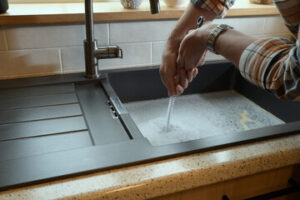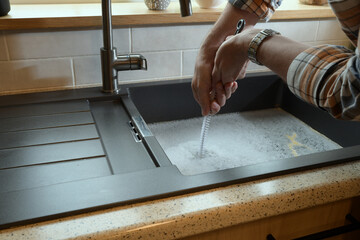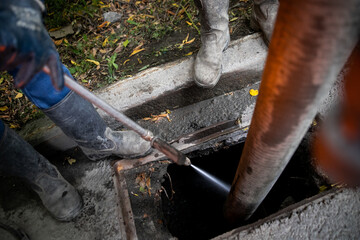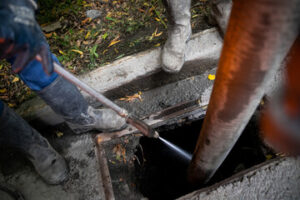Drain lines are susceptible to all sorts of issues that impact their function. From clogs to broken pipes, items that shouldn’t find their way into drain lines can result in serious damage and high repair costs.
If your drains clog repeatedly, it’s a sign of a bigger problem with the plumbing lines. Keep them clog-free with a few simple steps. For professional help, contact Drain Repair Near Me.
Drain clogs are among the most common home plumbing mishaps. Leaving them unattended can lead to water backing up into your sink, tub, or shower and can cause costly damage to the pipes. But if you can spot a clog developing, there are a number of easy and inexpensive ways to clear it without the need for a professional plumber.
Grease, soap scum, hair, paper products, and other waste can build up in your pipes over time to create major blockages. Keeping a close eye on your drains and taking the time to inspect them semi-regularly will help you detect problems in their early stages. A slow-moving sink or foul odors when running the garbage disposal are strong indicators that you have a clog in progress.
Most clogs can be resolved with basic household items such as plungers, drain snakes, hot water, and even drain cleaners. However, you should always consult a professional plumber before using chemical cleaners, as these can be damaging to your pipes.
If your clog is located in the sink, first remove the drain trap, which is the U-shaped pipe that sits underneath your sink. Place a bucket or sink stopper under the trap to catch any runoff. Loosen the setscrew on the bottom of the drain snake and pull out about six to 10 inches of cable. Thread the tip of the snake into the clogged drain and begin cranking it, feeding it into the pipe. The snake’s corkscrew-like shape is designed to navigate around corners and break up obstructions. If you feel resistance, loosen the set screw and pull out more cable.
If the simple methods above don’t work, try removing the grate on the drain. This will allow you to more easily reach the clog and may give you a chance to dislodge it. If you have a drain snake, thread it into the clogged drain and tighten the set screw. Turn the crank clockwise and feed the snake into the pipe. Its curved head is designed to corkscrew through and around obstructions, helping to break up and dislodge clogs.
Root Invasion
Roots invade pipe systems in search of water and nutrients. The tiniest openings in pipes are enough to trigger a root invasion, and these roots can cause serious damage and blockages within the sewer lines of homes and commercial buildings.
As a homeowner, you can do some things to reduce the chances of a root invasion in your drains. For example, regularly having your plumbing system cleaned by a professional can keep the drains clear. You should also ask your plumber to do a camera inspection of the drain lines every year. This will help them catch any signs of damage and remove the invading roots before they do more harm.
Invasive roots are a common problem for homeowners and businesses, but they can be hard to spot because most of the damage occurs underground and out of sight. If you suspect that you may have a root problem, look for symptoms like slow-flushing drains or multiple fixtures backing up at once. You should also watch out for wet spots and puddles around your property, as these can indicate a leaky or broken sewer line.
Once a tree’s roots have penetrated the sewer line, it’s essential to act quickly. Roots can grow very fast and do extensive damage to the piping structure, leading to cracks, leaks, and more. A professional plumber can inspect the piping structure and repair it with a structural lining to prevent further damage to your home or business.
One of the most effective ways to deal with an existing root intrusion is through hydrojetting. This process involves flushing out the pipes with high-powered water pressure that breaks up and removes root masses. This method is less invasive than other plumbing methods and is more effective in preventing future blockages from occurring.
A professional plumber will be able to identify the source of your drainage issues and recommend the appropriate solutions for your situation. Whether you need a trenchless sewer line repair or need to have your drains professionally cleaned, a reputable plumber will be able to get the job done right. After they have finished, they will test all the drains to make sure that everything is working properly. They will then provide you with a warranty to give you peace of mind that the work was done correctly.
Trenchless Pipe Lining
As a less invasive alternative to traditional pipe replacement, trenchless pipe lining is an innovative solution. Instead of digging extensive trenches that disturb your property, technicians insert a liner into the existing pipe and leave it to cure. The result is a new pipe within your old one that has the same strength and function as a brand-new pipe. This technology can repair pipes with cracked walls, missing sections, separated joints, and even root infiltration. The resulting pipe is stronger, more acid-resistant, and faster-flowing. It also comes with a 50-year warranty that covers both parts and labor.
The most common trenchless pipe lining methods include slip-lining, cured-in-place (CIPP) liners, and spray-applied pipe liners. These liners can be used on both gravity and pressure pipelines for water mains, sewer lines, and storm drains. However, before a pipe can be relined, it must be free of angularity and misalignments that could prevent the liner from fitting correctly. In addition, the access hole that is created for the insertion of the liner must be large enough to allow entry. Fortunately, these requirements are minimal, and the work can be done without disrupting the environment or the public.
There are several benefits to using trenchless pipe lining, including a shorter installation time and reduced environmental impact. Additionally, the cost of trenchless pipe lining is often significantly lower than the cost of traditional excavation and replacement. The only drawback to this method is that it is not suitable for all pipe conditions. For example, a belly in your existing sewer line—a low spot that causes wastewater to pool—is not repairable with this technique. In these cases, your plumber may recommend pipe bursting or traditional excavation methods.
Trenchless pipe lining requires fewer tools, a smaller crew, and less time to install than traditional techniques. This makes it a more affordable option for homeowners and business owners alike. However, it is important to work with an experienced technician to ensure that the lining process is carried out properly. A qualified technician will be able to identify the right pipe lining method for your unique needs and provide you with a comprehensive, long-term warranty.
Sewer Line Repair
When a home’s sewer lines begin to experience issues, it’s time for a professional inspection. A clogged line is not only unhygienic, but it can also lead to serious property damage. Allied provides quick, affordable repairs and replacements to keep your sewer line in good condition.
A sewer line clog is often caused by an accumulation of gunk that builds up over time. Items like toilet paper, hair, kitchen grease, and soap scum can block the line completely. A professional plumber will use a camera to view the condition of your pipes and determine the best way to unclog them. In some cases, a clog can be cleared using a plumber’s snake or drain chemicals. But if these methods fail, a sewer line repair may be necessary.
If your sewer line is experiencing significant damage, a full replacement may be needed. A plumbing professional will use a digital camera to see the state of your pipes and identify any cracks, holes, or collapsed sections. This information will help them decide whether a trenchless method or traditional sewer line replacement is the best option for your property.
Trenchless sewer pipe replacement is less invasive than traditional methods and can be done in just one or two days. A plumbing professional will replace the old pipes with durable resin-soaked pipes that can last up to 50 years. This method is more efficient than digging and works well on PVC, clay, or cast-iron pipes.
Some homeowners don’t realize that their sewer lines are damaged until they notice issues such as slow drains, damp soil around the home, sagging walls and floors, or a foul smell. Those who experience these warning signs should call a plumbing professional as soon as possible to avoid costly damage to their homes and health problems for their families.
It’s important to remember that not all damaged sewer lines require a complete replacement. In fact, a minimally invasive trenchless method such as sewer line lining or pipe bursting can sometimes do the trick. But for those whose pipes are beyond repair, a full replacement is often the best option.


